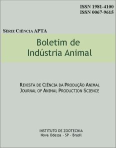Production and morphologic composition of tanzania grass pasture with and without irrigation
Keywords:
rotational grazing, accumulation forage rate, forage massAbstract
This study had the objective of evaluating the yield production of Panicum maximum cv. Tanzania using a production system with and without irrigation. The experiment was carried out at Embrapa Pecuária Sudeste, São Carlos, São Paulo State, from December 2003 to January 2005. The size of the experimental area was six ha, being three ha used without irrigation and three ha irrigated by conventional aspersion system. For both areas, the production system was the rotational grazed using holstein frisian cows, with a day of occupation and twenty-seven days of rest period. The pasture productivity was evaluated by the following variables: forage mass before and after the grazing, forage accumulation rate, and forage structures. For the total residue of post-grazing and leaves it was not observed significant effects of cycle grazing, treatment, and the interaction grazing cycle x treatment. As general, the total mass of forage before grazing and the stem mass before and after grazing were greater in the summer/autumn period and lower during the winter/spring time. The rate of forage accumulation was greater in the spring/summer and lower in the autumn/winter. The rate of stems accumulation was higher at february/2004 and january/2005. The experimental design was a replicated time measuring model analyzed by the Statistical Analysis Systems (SAS). The treatment with irrigation leaded to a greater production of forage during the summer/winter and spring/summer times. During those seasons, an anticipation in the forage mass growth was verified, related to the treatment without irrigation.
Downloads
Downloads
Published
Issue
Section
License
Os autores não serão remunerados pela publicação de trabalhos, pois devem abrir mão de seus direitos autorais em favor deste periódico. Por outro lado, os autores ficam autorizados a publicar seus artigos, simultaneamente, em repositórios da instituição de sua origem, desde que citada a fonte da publicação original seja Boletim de Indústria Animal. A revista se reserva o direito de efetuar, nos originais, alterações de ordem normativa, ortográfica e gramatical, com vistas a manter o padrão culto da língua e a credibilidade do veículo. Respeitará, no entanto, o estilo de escrever dos autores. Alterações, correções ou sugestões de ordem conceitual serão encaminhadas aos autores, quando necessário. Nesses casos, os artigos, depois de adequados, deverão ser submetidos a nova apreciação. As opiniões emitidas pelos autores dos artigos são de sua exclusiva responsabilidade. Todo o conteúdo deste periódico, exceto onde está identificado, está licenciado sob a Licença Creative Commons Attribution (CC-BY-NC). A condição BY implica que os licenciados podem copiar, distribuir, exibir e executar a obra e fazer trabalhos derivados com base em que só se dão o autor ou licenciante os créditos na forma especificada por estes. A cláusula NC significa que os licenciados podem copiar, distribuir, exibir e executar a obra e fazer trabalhos derivados com base apenas para fins não comerciais.













